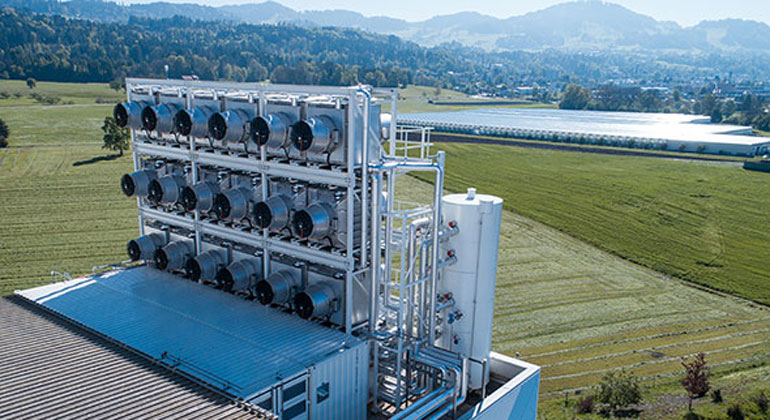Filtering a tonne of CO2 from the air burns a thousand kilowatt-hours of energy
Study provides first complete life-cycle analysis on resource consumption of “direct air capture”. Such plants could efficiently contribute to climate protection.
The village of Hilwil near Zurich, with a population of ten thousand, has become a kind of Mecca for the climate protection community: it is where the company Climeworks has operated a futuristic-looking pilot plant for “direct air capture” since 2017. Using chemical filters, the plant extracts 900 tonnes of the most important greenhouse gas, carbon dioxide (CO2), from the atmosphere every year. A new study now shows that this not only looks impressive but could indeed be useful on a large scale. The study is with contributions from the Berlin-based climate research institute MCC (Mercator Research Institute on Global Commons and Climate Change) and has been published in the renowned journal Nature Energy.
The researchers show for the first time the resource consumption over the entire life cycle of such filter systems. The study also looks at the chemicals (“sorbents”) needed to operate the filters, as well as the removal and storage of the extracted CO2. The resources considered are energy, materials, land area, water, and the particulate matter emissions released primarily during the construction and the eventual demolition of the plants. The analysis is based on data from Climeworks for the so-called TSA filter technology, and from the Canadian company Carbon Engineereing for the competing HAT-Aq process. The study also delivers a sensitivity analysis for alternative technical settings, for example a “greener” energy mix or a low-carbon supply chain for the sorbent.
“Our systematic approach makes it possible to render air filter systems truly comparable with all other climate protection options,” explains Felix Creutzig, head of the MCC working group Land Use, Infrastructure and Transport, and co-author of the paper. The study already uses the same classification scheme to assess bioenergy plantations, as well as emission reduction via electric cars instead of combustion engines, and heat pumps instead of gas boilers. “Air filters create a great deal of climate protection in a particularly small space, which is a big plus in view of the scarce resource of land worldwide,” says Creutzig. “In the short term, it should be more cost-effective to avoid carbon emissions – but in a decade or two, as the economy continues to decarbonise, this option could efficiently contribute to climate protection on a large scale.”
Filtering one tonne of CO2 out of the air with the TSA process used by Climeworks requires 1,000 kilowatt-hours of energy under current technical constraints. This is considerable, but still in the same order of magnitude as the additional green electricity demand for transport and heating transition. Also, supplies of 36 kilograms of material (including 7 tonnes of sorbent), and 3 cubic metres of water are needed, as well as 11,000 square metres of space for one year. In addition, it accounts for 180 grams of particulate matter emissions. The study also aggregates resource consumption according to its impact on climate. The bottom line is that currently, conventional DAC powered by gas is CO2-inefficient: for each tonne of CO2 filtered out, 300 kilos of CO2 equivalents will be emitted throughout the plant’s life cycle. With 580 kilos, the HAT-Aq process used by the company Carbon Engineering comes off even worse in comparison. However, in a scenario with low-carbon heat and power supply, these values drop significantly to 150 and 260 kilos respectively.
“There is a great concern that the air filter technology will not be sufficiently well-advanced for widespread use when it will be needed in a decade or two,” says Kavya Madhu, a PhD student at the University of Freiburg, and lead author of the study. “Given the current uncertainty about the exact technical implications, no business plans can be developed, or government funding identified. Our work provides a contribution to closing the striking innovation and policy gap in this regard.”
- Madhu, K., Pauliuk, S., Dhathri, S., Creutzig, F., 2021, Understanding environmental trade-offs and resource demand of direct air capture technologies through comparative life-cycle assessment, Nature Energy | https://rdcu.be/cAna / https://doi.org/10.1038/s41560-021-00922-6








